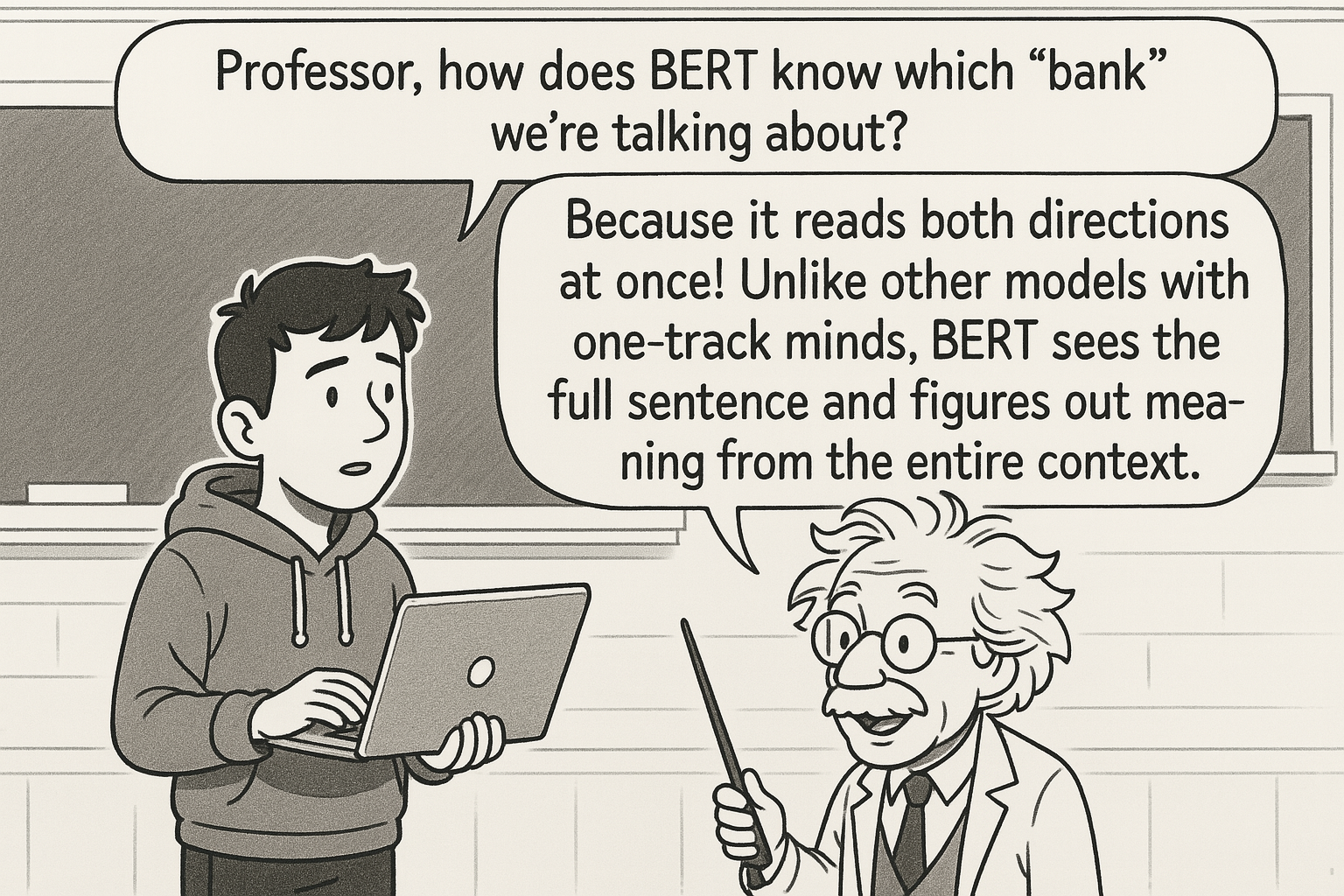Introduction
In 2019, researchers Jacob Devlin, Ming-Wei Chang, Kenton Lee, and Kristina Toutanova from Google AI Language published "BERT: Pre-training of Deep Bidirectional Transformers for Language Understanding" at NAACL. This paper introduced BERT (Bidirectional Encoder Representations from Transformers), a language representation model that fundamentally changed how machines understand human language. Unlike previous models that read text in one direction, BERT reads from both directions simultaneously, creating richer contextual understanding.
"Bidirectional context transforms language understanding from sequential guessing into comprehensive comprehension of meaning and relationships."
Core Ideas
BERT's approach centres on bidirectional pre-training using transformer architecture. The model's core insight was addressing a fundamental limitation in existing language models - they processed text either left-to-right or combined separate left-to-right and right-to-left models, but never truly integrated bidirectional context in the same layers.
The architecture uses a multi-layer bidirectional transformer encoder, essentially stacking transformer layers that can attend to context from both directions simultaneously. This bidirectional approach allows BERT to understand words in their complete context, considering all surrounding words rather than just preceding ones.
BERT employs two pre-training objectives that work together effectively. The Masked Language Model (MLM) randomly masks 15% of input tokens and trains the model to predict these masked words using bidirectional context. For instance, in the sentence "The cat sat on the [MASK]," BERT uses both "The cat sat on the" and the following context to predict "mat." The second objective, Next Sentence Prediction (NSP), trains BERT to understand relationships between sentence pairs by predicting whether one sentence logically follows another.
The model processes input through three types of embeddings that are summed together: token embeddings (representing actual words), segment embeddings (indicating which sentence the token belongs to), and position embeddings (showing the token's position in the sequence). This combination creates rich input representations that capture multiple aspects of language structure.
BERT uses WordPiece tokenisation with a 30,000 token vocabulary, enabling it to handle out-of-vocabulary words by breaking them into subword pieces. Special tokens like [CLS] at the beginning serve as aggregate sequence representations for classification tasks, while [SEP] tokens separate different sentences in paired inputs.
Breaking Down the Key Concepts
Think of traditional language models like reading a book with one eye covered - you can understand the story, but you miss important context clues. BERT is like reading with both eyes open, seeing the full picture simultaneously.
Previous models like GPT processed text sequentially, like reading word by word from left to right. If you encountered the word "bank" in a sentence, these models only knew what came before it. BERT, however, sees the entire sentence at once. When it encounters "bank," it simultaneously considers words like "river" that might come after it and "walked along the" that came before, instantly understanding we're talking about a riverbank, not a financial institution.
The masking strategy is like a sophisticated fill-in-the-blanks exercise. Imagine you're given the sentence "I love eating [BLANK] curry with naan bread." Even without seeing the masked word, you can guess it might be "chicken," "paneer," or "dal" based on the complete context. BERT learns language by solving millions of such puzzles, developing deep understanding of how words relate to each other.
The bidirectional transformer architecture works like having multiple expert editors reviewing text simultaneously. Each layer focuses on different aspects - some might notice grammatical patterns, others might understand semantic relationships, and deeper layers might grasp complex contextual nuances. All these layers work together, with information flowing in both directions, creating comprehensive understanding.

Results and Significance
BERT achieved remarkable breakthroughs across natural language processing benchmarks, establishing new state-of-the-art results on eleven different tasks. It pushed the GLUE benchmark score to 80.5% (a 7.7% absolute improvement), MultiNLI accuracy to 86.7% (4.6% absolute improvement), and SQuAD v1.1 question answering Test F1 to 93.2 (1.5% improvement).
It established the pre-train-then-fine-tune paradigm that became the foundation of modern NLP development. Instead of building task-specific models from scratch, developers could now take BERT's pre-trained knowledge and adapt it to specific applications with minimal additional training.
This approach democratised advanced NLP capabilities. Previously, only organisations with massive computational resources could build sophisticated language models. BERT made it possible for startups and individual developers to achieve state-of-the-art performance by fine-tuning pre-trained models on their specific datasets.
BERT's success sparked the transformer revolution that led to models like GPT-3, T5, and countless domain-specific variants. The architectural principles and training methodologies introduced in BERT became standard practice across the industry, influencing everything from search engines to chatbots to automated customer service systems.
The fine-tuning approach proved remarkably efficient. Developers could achieve excellent performance on diverse tasks like sentiment analysis, named entity recognition, and question answering by simply adding one additional output layer and training for a few epochs. This efficiency made advanced NLP accessible to projects with limited computational budgets.
Original paper can be found here - https://aclanthology.org/N19-1423/